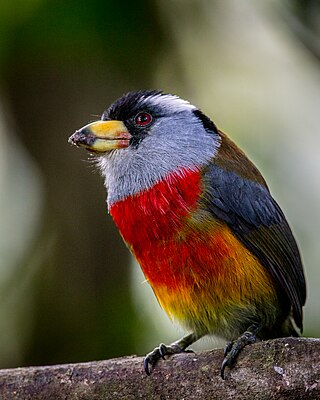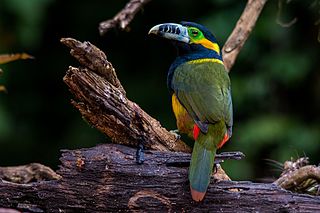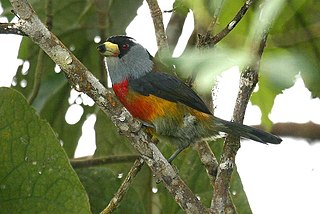
The New World barbets are a family, Capitonidae, of 15 birds in the order Piciformes, which inhabit humid forests in Central and South America. They are closely related to the toucans.

The toco toucan is a species of bird in the toucan family Ramphastidae. It is the largest species of toucan and has a distinctive appearance, with a black body, a white throat, chest and uppertail-coverts, and red undertail-coverts. Its most conspicuous feature is its massive beak, which is yellow-orange with a black base and large spot on the tip. It is endemic to South America, where it has a wide distribution from the Guianas south to northern Argentina and Uruguay, and its range has recently been expanding southwards. Unlike other toucans, which inhabit continuous forests, toco toucans inhabit a variety of semi-open habitats at altitudes of up to 1,750 m. They are especially common in the Brazilian cerrado, gallery forests, and the wetlands of the Pantanal.

The white-throated toucan is a near-passerine bird in the family Ramphastidae found in South America throughout the Amazon Basin including the adjacent Tocantins and Araguaia River drainage. It prefers tropical humid forest, but also occurs in woodland and locally in riverine forest within cerrado.

The collared aracari or collared araçari is a near-passerine bird in the toucan family Ramphastidae. It is found from Mexico to Colombia and Venezuela.

The Ramphastos genus, also known as toucans, is a genus of brightly colored, tropical birds that are found throughout Central and South America from Southern Mexico to the southern cone of the South American continent. Toucans are typically characterized by their large, colorful bills, which are used for a variety of functions such as thermoregulation, feeding, and social signaling.

An aracari or araçari is any of the medium-sized toucans that, together with the saffron toucanet, make up the genus Pteroglossus.

The toucan barbet is a barbet native to western Ecuador and Colombia. Along with the prong-billed barbet, it forms the family Semnornithidae, and is closely related to the toucans. It is a medium-sized barbet with a robust yellow bill. It has striking plumage, having a black head with grey throat and nape, red breast and upper belly, yellow lower belly and grey wings and tail.

The red-breasted toucan or green-billed toucan is a bird in the family Ramphastidae, the toucans, toucanets, and aracaris. It is found in Argentina, Brazil, Bolivia and Paraguay.

The green araçari, is a toucan, a near-passerine bird. It is found in the lowland forests of northeastern South America, in the northeast Amazon Basin, the Guianas and the eastern Orinoco River drainage of Venezuela. At 30–40 cm. (12–16 in) long and weighing 110–160 grams, it is the smallest aracari in its range, and among the smallest members of the toucan family.

The crimson-rumped toucanet is a near-passerine bird in the toucan family Ramphastidae. It is found in Colombia, Ecuador, and Venezuela.

The groove-billed toucanet is a near-passerine bird in the toucan family Ramphastidae. It is found in Colombia and Venezuela.

The saffron toucanet is a species of bird in the family Ramphastidae found in the Atlantic Forest in far north-eastern Argentina, south-eastern Brazil, and eastern Paraguay.

The pale-mandibled aracari or pale-billed araçari is a near-passerine bird in the toucan family Ramphastidae. It is found in Ecuador and Peru.

The many-banded aracari or many-banded araçari is a near-passerine bird in the toucan family Ramphastidae. It is found in Brazil, Colombia, Ecuador, Peru, and Venezuela.

The Guianan toucanet, or Guyana toucanet is a near-passerine bird in the toucan family Ramphastidae. It is found in Brazil, French Guiana, Guyana, Suriname, and Venezuela.

Gould's toucanet is a near-passerine bird in the toucan family Ramphastidae. It is found in Bolivia and Brazil.

The spot-billed toucanet is a near-passerine bird in the toucan family Ramphastidae. It is found in Argentina, Brazil, and Paraguay.

The tawny-tufted toucanet is a near-passerine bird in the toucan family Ramphastidae. It is found in Brazil, Colombia, Venezuela, and possible Guyana.

The yellow-eared toucanet is a near-passerine bird in the toucan family Ramphastidae. It is found from Honduras to Ecuador.

The toucan barbets are the small birds in the genus Semnornis. This was often included in the paraphyletic barbets but recently usually considered a distinct family Semnornithidae; alternatively, all barbets might be moved to the toucan family Ramphastidae as a subfamily, Semnornithinae. It contains only two species, the toucan barbet and the prong-billed barbet.

























